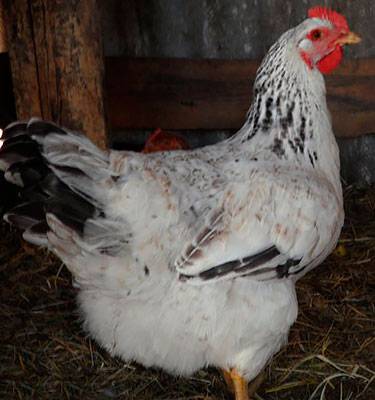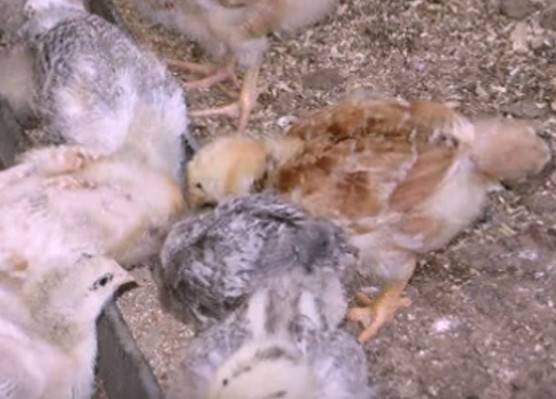Content
The origin of the Master Gray chicken breed is hidden in secrecy. There are two versions explaining where this meat-egg cross came from. Some believe that these chickens were bred in France, others that they were bred in Hungary by the Hubbard company.
In which country the breed was actually bred is unknown, because the ownership of the Hubbard company itself is shrouded in mystery. The company is international and they did not bother to indicate the address of the head office on the website. There are breeding centers in several countries, and their representatives work all over the world. The company's products come to Russia from Hungary. But the breed received its first recognition in France 20 years ago, hence the opinion that it was bred in this country.
Description of the Master Gray chicken breed
Master Gray chickens are named for the color of their plumage, which is dominated by gray feathers with chaotically scattered individual white and black feathers. The mottled pattern stands out most clearly in the neck area and along the edges of the wings. The markings on the body are smudged.
Chickens have powerful legs that support their large bodies. Laying hens weigh 4 kg, roosters grow to 6 kg. Master Gray hens begin to lay eggs even earlier than industrial egg crosses.
The meat is without excess fat, very tender. The large yield of dietary meat makes chicken suitable for making baby food. And there will also be people interested in large meaty legs.
Master Gray chickens have a very flexible disposition and a phlegmatic temperament. They tame very quickly. However, all crosses are distinguished by their lack of fear of humans. Many owners, having acquired chickens of this breed, refuse to keep ornamental chickens.
Pictured is the Master Gray cross:
Since this is a cross, the offspring are split according to genotype. Even a brilliant geneticist will not be able to breed a cross on his own using the parent breeds, for the simple reason that the original breeds are kept secret. Therefore, you will have to purchase chickens from Hubbard.
The chickens themselves can be used to hatch eggs from chickens of other breeds, but this may not be profitable unless we are talking about rare and expensive breeds for sale.
The disadvantage of the Master Gray chicken breed can be considered too slow weight gain compared to broiler crosses.
Plus on private farms - hens easily lay 200 eggs a year, but they don’t reach 300. According to the owners, this may happen because it is impossible to provide the best conditions for keeping poultry in the farmstead, similar to the conditions in poultry farms.
However, the same thing is observed in private farmsteads and when raising broilers, which is why the myth arose about the addition of steroids to broiler feed at poultry farms.
Content
The Master Gray chicken breed is distinguished by its high adaptive abilities and is unpretentious in its maintenance. But it still sets minimum requirements for its content. All requirements are dictated by the exceptionally large size of the chickens.
Chickens could satisfy their instinct to wallow in dust by bathing in sawdust, but it is ash that is needed. Chickens need to bathe in ash to kill the feather eaters that settle in the feather cover. Without sand, ash that is too light will quickly scatter throughout the chicken coop without bringing any benefit. To prevent ashes from flying everywhere, they mix them with sand.
The calculation of the area for chickens is made taking into account the fact that Master Gray chickens need much more space than ordinary chickens. Therefore, there should be no more than two chickens of this breed per square meter of floor area.
For winter maintenance, the chicken coop is insulated and equipped with infrared lamps. In addition to warmth, such lamps provide additional lighting on short winter days, helping to maintain the egg production of laying hens at a high level.
Feeding
Fundamentally, feed for Master Gray chickens is no different from feed for any other breed of chicken. If there is no goal to fatten chickens like broilers, then Master Gray food that is especially rich in protein and carbohydrates is not given.
Actually, feeding broilers and egg-laying chickens differs in that broilers focus on protein and carbohydrates, while egg-laying hens contain large quantities of vitamin E, calcium and protein.
Feed Master Gray at least 3 times a day. Grain is given in the morning and evening, and in the afternoon greens, vegetables and a wet mash with bran and dung. If there is a green area with weeds, you can let the chickens out there for a walk.
The diet of chickens must include food of animal origin: bone meal, meat and bone meal, blood meal or fish meal. To ensure shell strength, chickens will need mineral supplements in the form of ground egg shells, chalk or shellfish. Grains, greens and vegetables form the basis of the diet.
Pictured are day old Master Gray chicks:
Grown up chicken Master Gray:
Chickens under the age of one month should receive feed with a high protein content: finely chopped hard-boiled eggs, meat, chopped fish. It's also a good idea to add greens. You can use ready-made feed for chickens. But you need to be more careful with the feed, because when using feed for broilers, the chickens will grow faster, but will not lay eggs.
In addition to protein components, grains are also necessary. From the first day you can give boiled millet mixed with an egg. Although chickens with access to sand can also digest raw cereals.
From one and a half months, chickens are given “heavy” cereals: ground barley and wheat, with a high carbohydrate content. An increase in feed consumption occurs along with the growth of the chicken. For every kilogram of feed weight gained, the following is consumed:
- up to 2 weeks – 1.3 kg;
- from 2 weeks to 1 month – 1.7 kg;
- from 1 to 2 months – 2.3 kg.
For normal development, chickens should not lack food. To avoid malnutrition and the struggle for food, where the stronger will inevitably push the weaker away from the feeding trough, it is better not to skimp on food and give it in excess so that everyone can eat plenty.
Other breed options
The mysterious breed “Master Gris” is still the same “Master Gray”, but in the French interpretation of this name.
This is due to the fact that this breed of chicken comes to Russia from Hungary.
Based on the same parent breeds, Hubbard developed another line with a red color, which was called "Foxy chick"(literal translation "fox cheek"). Another name for this breed is "Red bro" They have similar characteristics to Master Gray, but their plumage is red.
The direction of this line is also egg-meat, but breeders believe that Red Bro is larger than Master Gray and lays better.
The photo shows a typical Red Bro or Foxy Chick chicken:
Day old Red Bro chicks:
Grown up red bro chick:
In addition to the original Master gray and Red bro, the company has already developed two more subspecies:
- Master Gray M – the result of crossing gray Master Gray roosters and Red Bro chickens;
- Master Gray S – the result of crossing Master Gray M roosters and Red Bro chickens.
Both subspecies differ from the original breeds in their pale yellow, almost white color, dark edging of the wings and a characteristic gray dot on the top of the head.
Pictured is the Master Gray M line:
And in the bottom photo is the next line Master Gray S, the color of which is a little more red.
Since Master Gray and Foxy Chick are similar in their characteristics, the chickens can be kept together from the first day. In case of warm weather, the chickens calmly walk outside in the enclosure.
Reviews from owners of Master Gray chickens
The owner of these chickens describes his impressions of Red Bro very well in the video:
Hubbard chickens are already very popular in the West and are becoming more and more famous throughout the CIS. They are a very good replacement in private farmsteads for broiler and egg industrial crosses that require special conditions.

















